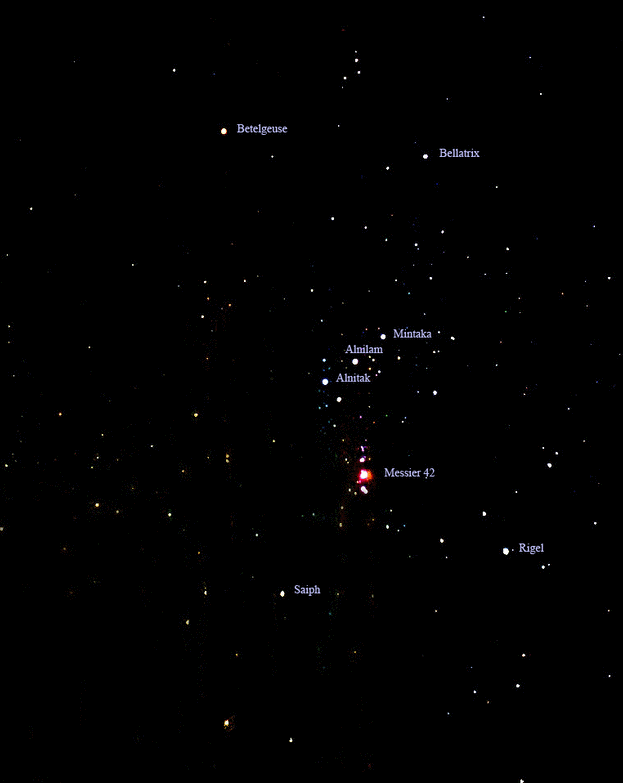
A view to south as seen tonight, 18 March at 8:30 PM, EDT, Orion and his faithful winter companion Canis Major, the Greater Dog, to his south and east. Image via Stellarium.
During these cold, clear winter nights in the Northern Hemisphere, the sky is adorned with a veritable treasure trove of jewels, ranging widely in brilliance, splendor and color.
As seen from mid-northern latitudes, the winter sky has one of the highest densities of bright stars for any given region of the sky. Even a casual observer can appreciate the assortment of bright stars, their splendor, diversity, density and brilliance unrivaled. Prominently placed, looking south between December and March, one quickly notices Orion, The Hunter with Canis Major, The Great Dog, to the south and east [of Orion] and Canis Minor to the north of Canis Major. At this time in late December, Orion can be seen prominently ascending the Southeast sky. All three constellations are among Ptolemy’s original 48, are equally rich in content and splendor and have many similarities and it is thus fitting to discuss them all together.
Contained in Orion and Canis Major are the stars Rigel and Sirius, both stars providing an excellent object lesson in comparative luminosities. Rigel is 800 light years distant and Sirius is a mere 8.7 light years distant so what does this similarity in brightness and such a disparity in distance suggest about their intrinsic luminosities? Rigel is an extraordinarily powerful star, has 9 times the mass of Sirius and is78 times the sun’s size with an effective temperature over twice that of the sun. Sirius, as a comparison, is not quite twice the size of the sun and is twice its mass. At 800 light years distant and appearing almost as bright as Sirius, one gets a good sense of the awesome power of Rigel compared to the sun or Sirius. Rigel represents the left knee of the celestial hunter while Saiph, his right knee, Betelgeuse, his right shoulder and Bellatrix, his left shoulder.

Orion as imaged by the author in 1970 showing the famous nebula that bears the celestial hunter’s name, Messier-42. 50 mm F/2.8, guided 10 minute exposure, Ektachrome 400 HS film, rural Long Island
Standard, unaided views of Orion show the three familiar belt stars with Saiph at the lower left, Rigel at the lower right, Betelgeuse at the upper left and Bellatrix at the upper right.
Known to the Spanish as Las Tres Marias (The Three Marys) or Los Reyes Magos (The Magic Kings), the three belt stars, Alnitak, Alnilam and Mintaka are brilliant, luminous stars in their own right with the biblical reference no doubt indicative of the seasonal significance of Orion’s visibility during the Christmas season. In the later instance, it is clearly a reference to the Gospel of Matthew’s account of three wise men, characterized as kings, all bearing gifts for the infant Jesus.
Visible due south of the hunter’s belt is one the most famous in the winter showcase of celestial jewels, the Great Nebula (Nebula is Latin for “Cloud”) in Orion or Messier 42 (Charles Messier was an 18th century French astronomer who compiled a catalog of “non-stellar” objects and the Great Nebula in Orion is number 42 in his catalog). Located in the “Sword of Orion” and caused to shine by the intense ultraviolet light of the hot, brilliant, blue-white stars contained within, this ethereal beauty, composed primarily of hydrogen, the raw material of stars, is a veritable stellar nursery, one of many in the region where star formation is ongoing.

A composite zoom-in of the Great Nebula in Orion from a standard, naked-eye view of Orion followed by a telephoto view and, finally, a telescopic view. Image credit: the author. Note: this is an animated GIF and includes a telescopic close-up of the nebula as the final image in the gif.

Image of Messier-42 as imaged by the author with his 20 cm (0.2 meter) telescope. Note this image is oriented the same as would be seen by a naked-eye observer and has the same orientation as the previous animated zoom of this same region.
To the west of Orion and standing upright is his perennially faithful hunting companion, Canis Major, the Great Dog. Sirius, the brightest star in the sky as seen from both hemispheres, marks the head of the dog and the star Wezen marks his hind quarters.

The constellation Canis Major with two principal stars labeled, Sirius, the head of the dog and Wezen, the dog’s hind quarters. Just south of Sirius is M-41, a beautiful, open star cluster and number 41 in the catalog of Charles Messier. This view of Canis Major was obtained by the author on the occasion of his visit to the Everglades (Florida, USA) during the winter of 1986 to observe Comet Halley. Image credit: the author.
Looking at Canis Major, above, take note of the location of M-41, a beautiful, open star cluster and number 41 in Charles Messier’s catalog of non-stellar objects. This object is one of many such objects in this region of the sky that make for great binocular targets. The following telescopic view gives a good sense of what one would see with a moderately powerful pair of binoculars.

Telescopic view of the beautiful open star cluster, M-41. Image credit: the author. Instrument: 20 cm (0.2 meter) reflector, F/7, 10 minute guided exposure, Ektachrome 400 HS film
To the north of Canis Major is his smaller companion, Canis Minor, the Lesser Dog.
Mythology
Orion was a great hunter whom Zeus placed among the stars and whose name derives from Greek mythology. He was gigantic and powerful, a supernaturally strong hunter of ancient times who was born to Euryale, a Gorgon, and Poseidon, god of the sea.
According to Greek lore, Canis Major represented the dog Laelaps, a gift from Zeus to Europa and was also one of Orion’s two hunting dogs, pursuing Lepus the Hare (due south of Orion) or assisting Orion in his battles with Taurus the Bull.
Though strongly associated with Classical Greek mythology, Canis Minor originates from ancient Mesopotamia and is often associated with the Teumessian Fox, a beast turned into stone with its hunter, Laelaps, by Zeus, who subsequently placed them all among the stars as Canis Major (Laelaps) and Canis Minor (Teumessian Fox).
It is written that, as a reward for his faithfulness, Canis Minor was placed along the banks of the Milky Way, a body believed to be a heavenly river and a place where the faithful canine would never suffer from thirst.
Although Canis Minor was one of Ptolemy’s original 48 constellations in which it was defined as a recognizable pattern (stellar asterism), he identified only two stars and hence no depiction was possible.
On Twitter: https://twitter.com/astronomychange
Patreon: https://www.patreon.com/astronomyforchange



